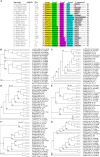Structure-Function and Therapeutic Potential of Spider Venom-Derived Cysteine Knot Peptides Targeting Sodium Channels
- PMID: 31031623
- PMCID: PMC6470632
- DOI: 10.3389/fphar.2019.00366
Structure-Function and Therapeutic Potential of Spider Venom-Derived Cysteine Knot Peptides Targeting Sodium Channels
Abstract
Spider venom-derived cysteine knot peptides are a mega-diverse class of molecules that exhibit unique pharmacological properties to modulate key membrane protein targets. Voltage-gated sodium channels (NaV) are often targeted by these peptides to allosterically promote opening or closing of the channel by binding to structural domains outside the channel pore. These effects can result in modified pain responses, muscle paralysis, cardiac arrest, priapism, and numbness. Although such effects are often deleterious, subtype selective spider venom peptides are showing potential to treat a range of neurological disorders, including chronic pain and epilepsy. This review examines the structure-activity relationships of cysteine knot peptides from spider venoms that modulate NaV and discusses their potential as leads to novel therapies for neurological disorders.
Keywords: ICK peptides; novel drugs; spider venoms; structure–activity relationship; voltage-gated ion channels.
Figures





Similar articles
-
Spider Knottin Pharmacology at Voltage-Gated Sodium Channels and Their Potential to Modulate Pain Pathways.Toxins (Basel). 2019 Oct 29;11(11):626. doi: 10.3390/toxins11110626. Toxins (Basel). 2019. PMID: 31671792 Free PMC article. Review.
-
Modulatory features of the novel spider toxin μ-TRTX-Df1a isolated from the venom of the spider Davus fasciatus.Br J Pharmacol. 2017 Aug;174(15):2528-2544. doi: 10.1111/bph.13865. Epub 2017 Jun 27. Br J Pharmacol. 2017. PMID: 28542706 Free PMC article.
-
Multi-targeting sodium and calcium channels using venom peptides for the treatment of complex ion channels-related diseases.Biochem Pharmacol. 2020 Nov;181:114107. doi: 10.1016/j.bcp.2020.114107. Epub 2020 Jun 21. Biochem Pharmacol. 2020. PMID: 32579958 Review.
-
A subfraction obtained from the venom of the tarantula Poecilotheria regalis contains inhibitor cystine knot peptides and induces relaxation of rat aorta by inhibiting L-type voltage-gated calcium channels.Toxicon X. 2023 Feb 17;18:100151. doi: 10.1016/j.toxcx.2023.100151. eCollection 2023 Jun. Toxicon X. 2023. PMID: 36873112 Free PMC article.
-
Efficient Enzymatic Ligation of Inhibitor Cystine Knot Spider Venom Peptides: Using Sortase A To Form Double-Knottins That Probe Voltage-Gated Sodium Channel NaV1.7.Bioconjug Chem. 2018 Oct 17;29(10):3309-3319. doi: 10.1021/acs.bioconjchem.8b00505. Epub 2018 Sep 12. Bioconjug Chem. 2018. PMID: 30148615
Cited by
-
General mechanism of spider toxin family I acting on sodium channel Nav1.7.Zool Res. 2022 Sep 18;43(5):886-896. doi: 10.24272/j.issn.2095-8137.2022.185. Zool Res. 2022. PMID: 36052553 Free PMC article.
-
Selective Targeting of Nav1.7 with Engineered Spider Venom-Based Peptides.Channels (Austin). 2021 Dec;15(1):179-193. doi: 10.1080/19336950.2020.1860382. Channels (Austin). 2021. PMID: 33427574 Free PMC article. Review.
-
Lessons learned in translating pain knowledge into practice.Pain Rep. 2023 Nov 2;8(6):e1100. doi: 10.1097/PR9.0000000000001100. eCollection 2023 Dec. Pain Rep. 2023. PMID: 37928204 Free PMC article.
-
Peripheral Voltage-Gated Cation Channels in Neuropathic Pain and Their Potential as Therapeutic Targets.Front Pain Res (Lausanne). 2021 Dec 13;2:750583. doi: 10.3389/fpain.2021.750583. eCollection 2021. Front Pain Res (Lausanne). 2021. PMID: 35295464 Free PMC article. Review.
-
Functional effects of drugs and toxins interacting with NaV1.4.Front Pharmacol. 2024 Apr 25;15:1378315. doi: 10.3389/fphar.2024.1378315. eCollection 2024. Front Pharmacol. 2024. PMID: 38725668 Free PMC article. Review.
References
-
- Agwa A. J., Lawrence N., Deplazes E., Cheneval O., Chen R., Craik D. J., et al. (2017). Spider peptide toxin HwTx-IV engineered to bind to lipid membranes has an increased inhibitory potency at human voltage-gated sodium channel hNaV1.7. Biochim. Biophys. Acta 1859 835–844. 10.1016/j.bbamem.2017.01.020 - DOI - PubMed
Publication types
LinkOut - more resources
Full Text Sources

